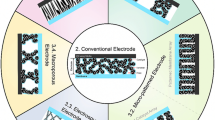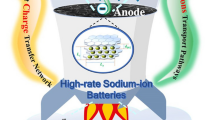Abstract
Electrolytes consisting of methylcellulose/potato starch blend incorporated with ammonium nitrate (NH4NO3) are prepared by solution cast method. Field emission scanning electron microscopy (FESEM) discovers that methylcellulose and starch are miscible. Cation transference number (tcat) of the highest conducting electrolyte is discovered to be 0.40. Linear sweep voltammetry (LSV) show that the electrolyte is stable in the voltage range of 1.50 to 1.88 V from 298 to 343 K. Protonic conduction in the electrolyte has been further proven via cyclic voltammetry using both reversible Zn + ZnSO4·7H2O and blocking stainless steel electrodes. The open circuit voltage (Voc) of the protonic cell is lasted for 24 h at 1.52 V. The value of Voc is inversely proportional to the temperature. The maximum capacity, internal resistance, and power density of the protonic cell at 343 K are found to be 42 mA h, 17 Ω, and 13.5 mW cm−2, respectively. Rechargeability of the protonic cell has been examined for 15 cycles at different constant current.













Similar content being viewed by others
Reference
Hashmi SA, Latham RJ, Linford RG, Schlindwein WS (1998) Conducting polymerbased electrochemical redox supercapacitors using proton and lithium ion conducting polymer electrolytes. Polym Int 47:28–33. https://doi.org/10.1002/(SICI)1097-0126(199809)47
Panero S, Ciuffa F, D’Epifano A, Scrosati B (2003) New concepts for the development of lithium and proton conducting membranes. Electrochim Acta 48(14–16):2009–2014. https://doi.org/10.1016/S0013-4686(03)00179-8
Shukur MF, Kadir MFZ Hydrogen ion conducting starch-chitosan blend based electrolyte for application in electrochemical devices. Electrochim Acta 158:152–165. https://doi.org/10.1016/j.electacta.2015.01.167
Dose WM, Donne SW (2014) Optimising heat treatment environment and atmosphere of electrolytic manganese dioxide for primary Li/MnO2 batteries. J Power Sources 247:852–857. https://doi.org/10.1016/j.jpowsour.2013.08.142
Chen T, Ma H, Kong D Discharge performance of nanostructured PbO2 microspheres as the positive active material. Mater Lett 90:103–106. https://doi.org/10.1016/j.matlet.2012.09.058
Wang H, Bai Y, Chen S, Luo X, Wu C, Wu F, Lu J (2015) Binder-free V2O5 cathode for greener rechargeable aluminum battery. ACS Appl Mater Interfaces 7:80–84. https://doi.org/10.1021/am508001h
Ali AMM, Mohamed NS, Arof AK (1998) Polyethylene oxide (PEO)–ammonium sulfate ((NH4)2SO4) complexes and electrochemical cell performance. J Power Sources 74:135–141. https://doi.org/10.1016/S0378-7753(98)00045-7
Alias SS, Chee SM, Mohamad AA Chitosan–ammonium acetate–ethylene carbonate membrane for proton batteries. Arab J Chem 10:S3687–S3698. https://doi.org/10.1016/j.arabjc.2014.05.001
Ramesh S, Liew CW, Arof AK (2011) Ion conducting corn starch biopolymer electrolytes doped with ionic liquid 1-butyl-3-methylimidazolium hexafluorophosphate. J Non-Cryst Solids 357:3654–3660. https://doi.org/10.1016/j.jnoncrysol.2011.06.030
Shuhaimi NEA, Alias NA, Kufian MZ, Majid SR, Arof AK (2010) Characteristics ofmethyl cellulose-NH4NO3-PEG electrolyte and application in fuel cells. J Solid State Electrochem 14:2153–2159. https://doi.org/10.1007/s10008-010-1099-4
Andrade J, Raphael E, Pawlicka A (2009) Plasticized pectin-based gel electrolytes. Electrochim Acta 54:6479–6483. https://doi.org/10.1016/j.electacta.2009.05.098
Mobarak NN, Ramli N, Ahmad A, Rahman MYA (2013) Chemical interaction and conductivity of carboxymethyl κ-carrageenan based green polymer electrolyte. Solid State Ionics 224:51–57. https://doi.org/10.1016/j.ssi.2012.07.010
Shukur MF, Majid NA, Ithnin R, Kadir MFZ (2013) Effect of plasticization on the conductivity and dielectric properties of starch–chitosan blend biopolymer electrolytes infused with NH4Br. Phys Scr T157:014051. https://doi.org/10.1088/0031-8949/2013/T157/014051
Tan CH, Ahmad A, Anuar FH (2014) Synthesis and characterization of polylactide-poly(ethylene glycol) block copolymer as solid polymer electrolyte. Asian J Chem 26:S230–S236. https://doi.org/10.14233/ajchem.2014.19059
Kadir MFZ, Hamsan MH (2017) Green electrolytes based on dextran-chitosan blend and the effect of NH4SCN as proton provider on the electrical response studies. Ionics 24:2379–2398. https://doi.org/10.1007/s11581-017-2380-7
Song A, Huang Y, Zhong X, Cao H, Liu B, Lin Y, Wang M, Li X (2017) Gel polymer electrolyte with high performances based on pure natural polymer matrix of potato starch composite lignocelluloses. Electrochim Acta 245:982–992. https://doi.org/10.1016/j.electacta.2017.05.176
Song A, Huang Y, Liu B, Cao H, Zhong X, Lin Y, Wang M, Li X, Zhong W (2017) Gel polymer electrolyte based on polyethylene glycol compositelignocellulose matrix with higher comprehensive performances. Electrochim Acta 247:505–515. https://doi.org/10.1016/j.electacta.2017.07.048
Kampeerapappun P, Aht-ong D, Srikulkit K (2007) Preparation of cassava starch/montmorillonite composite film. Carbohydr Polym 67:155–163. https://doi.org/10.1016/j.carbpol.2006.05.012
Abd El-Kader MFH, Ragab HS (2013) DC conductivity and dielectric properties of maize starch/methylcellulose blend films. Ionics 19:361–369. https://doi.org/10.1007/s11581-012-0742-8
Miyamoto H, Yamane C, Seguchi M, Okajima K (2009) Structure and properties of cellulose-starch blend films regenerated from aqueous sodium hydroxide solution. Food Sci Technol Res 15:403–412. https://doi.org/10.3136/fstr.15.403
Fan L, Dang Z, Nan CW, Li M (2002) Thermal, electrical and mechanical properties of plasticized polymer electrolytes based on PEO/P(VDF-HFP) blends. Electrochim Acta 48:205–209. https://doi.org/10.1016/S0013-4686(02)00603-5
Ibrahim S, Yasin SMM, Nee NM, Ahmad R, Johan RM (2012) Conductivity and dielectric behaviour of PEO-based solid nanocomposite polymer electrolytes. Solid State Commun 152:426–434. https://doi.org/10.1016/j.ssc.2011.11.037
Kumar M, Sekhon SS (2002) Role of plasticizer’s dielectric constant on conductivity modification of PEO–NH4F polymer electrolytes. Eur Polym J 38:1297–1304. https://doi.org/10.1016/S0014-3057(01)00310-X
Hamsan MH, Shukur MF, Kadir MFZ (2017) The effect of NH4NO3 towards the conductivity enhancement and electrical behavior in methyl cellulose-starch blend based ionic conductors. Ionics 23:1137–1154. https://doi.org/10.1007/s11581-016-1918-4
Shuhaimi NEA, Majid SR, Arof AK (2009) On complexation between methyl cellulose and ammonium nitrate. Mater Res Innov 13:239–242. https://doi.org/10.1179/143307509X440406
Khiar AS, Arof AK (2010) Conductivity studies of starch-based polymer electrolytes. Ionics 16:123–129. https://doi.org/10.1007/s11581-009-0356-y
Hamsan MH, Shukur MF, Kadir MFZ (2017) NH4NO3 as charge carrier contributor in glycerolized potato starch-methyl cellulose blend-based polymer electrolyte and the application in electrochemical double-layer capacitor. Ionics 23:3429–3453. https://doi.org/10.1007/s11581-017-2155-1
Kuo CW, Huang CW, Chen BK, Li WB, Chen PR, Ho TH, Tseng CG, Wu TY (2013) Enhanced ionic conductivity in PAN–PEGME-LiClO4-PC composite polymer electrolytes. Int J Electrochem Sci 8:3834–3850
Watanabe M, Nagano S, Sanui K, Ogata N (1988) Estimation of Li+ transport number in polymer electrolytes by the combination of complex impedance and potentiostatic polarization measurements. Solid State Ionics 28–30:911–917. https://doi.org/10.1016/0167-2738(88)90303-7
Wagner JB, Wagner CB (1957) Electrical conductivity measurements on cuprous halides. J Chem Phys 26:1597–1601. https://doi.org/10.1063/1.1743590
Samsudin AS, Lai HM, Isa MIN (2014) Biopolymer materials based carboxymethyl cellulose as a proton conducting biopolymer electrolyte for application in rechargeable proton battery. Electrochim Acta 129:1–13. https://doi.org/10.1016/j.electacta.2014.02.074
Halal TY, Colussi R, Deon VG, Pinto VZ, Villanova FA, Carreno NLV, Zavareze ER (2015) Films based on oxidized starch and cellulose from barley. Carbohydr Polym 133:644–653. https://doi.org/10.1016/j.carbpol.2015.07.024
Yusof YM, Kadir MFZ (2016) Electrochemical characterizations and the effect of glycerol in biopolymer electrolytes based on methylcellulose-potato starch blend. Mol Cryst Liq Cryst 627:220–233. https://doi.org/10.1080/15421406.2015.1137115
Tongdeesoon W, Mauer LJ, Wongruong S, Sriburi P, Rachtanap P (2011) Effect of carboxymethyl cellulose concentration on physical properties of biodegradable cassava starch-based films. Chem Cent J 5:1. https://doi.org/10.1186/1752-153X-5-6
Babu K, Bera A, Kumari K, Mandal A, Saxena VK (2014) Characterization and application of methylcellulose and potato starch blended films in controlled release of urea. J Polym Eng 35(79). https://doi.org/10.1515/polyeng-2014-0118
Salleh NS, Aziz SB, Aspanut Z, Kadir MFZ (2016) Electrical impedance and conduction mechanism analysis of biopolymer electrolytes based on methyl cellulose doped with ammonium iodide. Ionics 22:2157–2167. https://doi.org/10.1007/s11581-016-1731-0
Azli AA, Manan NSA, Kadir MFZ (2017) The development of Li+ conducting polymer electrolyte based on potato starch/graphene oxide blend. Ionics 23:411–425. https://doi.org/10.1007/s11581-016-1874-z
Arya A, Sharma AL (2018) Optimization of salt concentration and explanation of two peak percolation in blend solid polymer nanocomposite films. J Solid State Electrochem 22:2725–2745
Kadir MFZ (2010) Characteristics of proton conducting PVA-chitosan polymer blend electrolytes. Ph.D Thesis, University of Malaya
Latif F, Aziz M (2013) The anti-plasticization effects of dimethyl carbonate plasticizer in poly (methyl metacrylate) electrolyte containing rubber. Mater Sci Appl 4:663–666. https://doi.org/10.4236/msa.2013.411082
Gobel K, Kachan DK (2018) Ionic conductivity and relaxation studies in PVDF-HFP:PMMA-based gel polymer blend electrolyte with LiClO4 salt. J Adv Dielectr 8:1850005–1850018. https://doi.org/10.1142/S2010135X18500054
Woo HJ, Majid SR, Arof AK (2011) Transference number and structural analysis of proton conducting polymer electrolyte based on poly(ϵ-caprolactone). Mater Res Innov 15:s49–s54. https://doi.org/10.1179/143307511X13031890747697
Shukur MF, Kadir MFZ (2014) Electrical and transport properties of NH4Br-doped corn starch-based solid biopolymer electrolyte. Ionics 136:204–217
Kufian MZ, Aziz MF, Shukur MF, Rahim AS, Ariffin NE, Shuhaimi NEA, Majid SR, Yahya R, Arof AK (2012) PMMA LiBOB gel electrolyte for application in lithium ion batteries. Solid State Ionics 208:36–42
Yusof YM, Illias HA, Shukur MF, Kadir MFZ (2017) Characterization of starch-chitosan blend-based electrolyte doped with ammonium iodide for application in proton batteries. Ionics 23:681–697. https://doi.org/10.1007/s11581-016-1856-1
Lee JH, Lee AS, Lee J-C, Hong M, Hwang SS, Koo CM (2015) Hybrid ionogel electrolytes for high temperature lithium batteries. J Mater Chem A 3:2226–2233. https://doi.org/10.1039/C4TA06062H
Lee H, Kim J, Lim T, Sung Y-E, Kim HJ, Lee HN, Kwon OJ, Cho YH (2017) A facile synthetic strategy for iron, aniline-based non-precious metal catalysts for polymer electrolyte membrane fuel cell. Sci Rep 7:5396. https://doi.org/10.1038/s41598-017-05830-y2017
Cao X, He X, Wang J, Liu H, Roser S, Rad BR, Evertz M, Streipert B, Li J, Wagner R, Winter M, Cekic-Laskovic I (2016) High voltage LiNi0.5Mn1.5O4/Li4Ti5O12 Lithium ion cells at elevated temperatures: carbonate versus ionic liquid-based electrolytes. ACS Appl Mater Interfaces 8:25971–25978. https://doi.org/10.1021/acsami.6b07687
Pratap R, Singh B, Chandra S (2006) Polymeric rechargeable solidstate proton battery. J Power Sources 161:702–706. https://doi.org/10.1016/j.jpowsour.2006.04.020
Sellam HSA (2012) Enhanced zinc ion transport in gel polymer electrolyte: effect of nano-sized ZnO dispersion. J Solid State Electrochem 16:3105–3114. https://doi.org/10.1007/s10008-012-1733-4
Kumar D, Hashmi SA (2010) Ion transport and ion–filler-polymer interaction in poly(methyl methacrylate)-based, sodium ion conducting, gel polymer electrolytes dispersed with silica nanoparticles. J Power Sources 195:5101–5108. https://doi.org/10.1016/j.jpowsour.2010.02.026
Munichandraiah N, Scanlon LG, Marsh RA, Kumar B, Sircar AK (1995) Influence of zeolite on electrochemical and physicochemical properties of polyethylene oxide solid electrolyte. J Appl Electrochem 25:857–863. https://doi.org/10.1007/bf00233905
Monisha S, Mathavana T, Selvasekarapandian S, Milton T, Franklin B, Aristatil G, Mani N, Premalatha M, Vinoth D (2017) Investigation of bio polymer electrolyte based on cellulose acetate-ammonium nitrate for potential use in electrochemical devices. Carbohydr Polym 157:38–47. https://doi.org/10.1016/j.carbpol.2016.09.026
Mishra K, Hashmi SA, Rai DK (2014) Studies on a proton battery using gel polymer electrolyte. High Perform Polym 26:672–676. https://doi.org/10.1177/0954008314537540
Ng LS, Mohamad AA (2008) Effect of temperature on the performance of proton batteries based on chitosan–NH4NO3–EC membrane. J Membr Sci 325:653–657. https://doi.org/10.1016/j.memsci.2008.08.029
Vanysek P (2011) Electrochemical series. In: Haynes WM (ed) Handbook of chemistry and physics, 92nd edn. CRC, Press, Boca Raton, pp 5–80
Botte GG, Muthuvel M (2012) Electrochemical energy storage: applications, processes, and trends. In: Kent JA (ed) Handbook of industrial chemistry and biotechnology. Springer, Palmetto Bay, p 1497
McComsey DW (2001) Zinc-carbon batteries (Leclanche and zinc chloride cell systems), in: D. Linden. In: Reddy TB (ed) Handbook of Batteries, 3rd edn. McGraw-Hill Professional, New York 8, 1
Rahman MM, Gruner G, Al-Ghamdi MS, Daous MA, Khan SB, Asiri AM (2013) Chemo-sensors development based on low-dimensional codoped Mn2O3-ZnO nanoparticles using flat-silver electrodes. Chem Cent J 7:60. https://doi.org/10.1186/1752-153X-7-60
Wang CY, Sun J, Liu HK, Dou SX, MacFarlace D, Forsyth M (2005) Potential application of solid electrolyte P11 OH in Ni/MH batteries. Synth Met 152:57–60. https://doi.org/10.1016/j.synthmet.2005.07.125
Roscher MA, Bohlen O, Vetter J (2011) OCV hysteresis in Li-ion batteries including two-phase transition materials. Int J Electrochem 2011:984320. https://doi.org/10.4061/2011/984320
Broadhead J, Kuo HC (2001) In: Linden D, Reddy TB (eds) Electrochemical principles and reactions, 3rd ed; handbook of batteries, vol 2. McGraw-hill, New York, pp 10–2.37
Yap SC, Mohamad AA (2007) Proton batteries with hydroponics gel as gel polymer electrolyte. Electrochem Solid-State Lett 10:A139–A141. https://doi.org/10.1149/1.2717366
Mohamed NS, Subban RHY, Arof AK (1995) Polymer batteries fabricated from lithium complexed acetylated chitosan. J Power Sources 56:153–156. https://doi.org/10.1016/0378-7753(95)80027-E
Kadir MFZ, Majid SR, Arof AK (2010) Plasticized chitosan-PVA blend polymer electrolyte based proton battery. Electrochim Acta 55:1475–1482. https://doi.org/10.1016/j.electacta.2009.05.011
Jamaludin A, Mohamad A (2010) Application of liquid gel polymer electrolyte based on chitosan-NH4NO3 for proton batteries. J Appl Polym Sci 118:1240–1243. https://doi.org/10.1002/app.32445
Mishra K, Hashmi SA, Rai DK (2013) Nanocomposite blend gel polymer electrolyte for proton battery application. J Solid State Electrochem 17:785–793. https://doi.org/10.1007/s10008-012-1926-x
Mishra K, Hashmi SA, Rai DK (2014) Protic ionic liquid-based gel polymer electrolyte: structural and ion transport studies and its application in proton battery. J Solid State Electrochem 18:2255–2266. https://doi.org/10.1007/s10008-014-2475-2
Funding
This study is supported by the Ministry of Higher Education (MOHE) and University of Malaya with grant nos. FP009-2015A and BKS005-2018.
Author information
Authors and Affiliations
Corresponding author
Additional information
Publisher’s note
Springer Nature remains neutral with regard to jurisdictional claims in published maps and institutional affiliations.
Rights and permissions
About this article
Cite this article
Hamsan, M.H., Aziz, S.B., Shukur, M.F. et al. Protonic cell performance employing electrolytes based on plasticized methylcellulose-potato starch-NH4NO3. Ionics 25, 559–572 (2019). https://doi.org/10.1007/s11581-018-2827-5
Received:
Revised:
Accepted:
Published:
Issue Date:
DOI: https://doi.org/10.1007/s11581-018-2827-5




